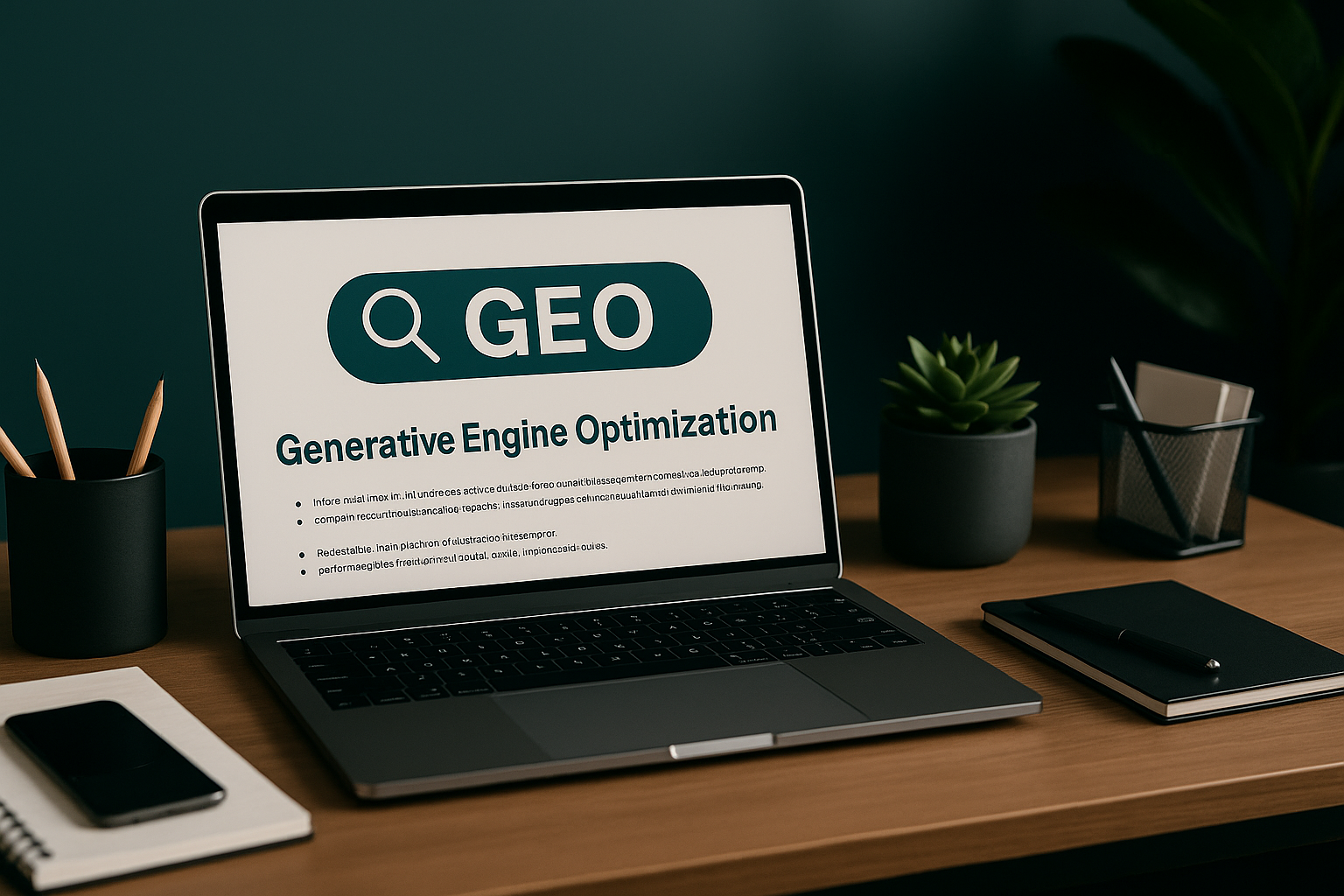Generative AI has altered the mechanics of discovery in ways traditional search alone never could. Instead of skimming through ranked links, people now ask questions conversationally and receive synthesized answers on the spot. For businesses, that means visibility is no longer measured by position on a page, but by whether their expertise is chosen as raw material for an AI’s response.
Think of it less like competing for billboards along a highway and more like contributing bricks to the foundation of a city: the stronger and clearer your contribution, the more often it’s built into the structures people actually use. That shift is the essence of Generative Engine Optimization (GEO) – the art and science of shaping your content so machines can recognize, trust, and reuse it.
This guide breaks down what GEO is, how it works in practice, why it matters strategically, and the practical steps any business can take to adapt. Along the way, we’ll also touch on related areas like Answer Engine Optimization (AEO) and tactical quick wins that deserve deeper exploration on their own. Stay tuned!
What Is Generative Engine Optimization (GEO)
Generative Engine Optimization (GEO) is the process of shaping your content so it isn’t just visible on a SERP (Search Engine Results Page), but selected and reused in the answers produced by generative AI systems. That shift means content must be more than discoverable – it has to be clear, authoritative, and structured in ways machines can confidently draw from.
To understand what this means in action, it helps to look at how generative engines actually build their answers, and where GEO fits into that process.
How GEO Works in Practice
Generative engines don’t simply return a list of links; they create synthesized answers by pulling fragments from multiple sources. Each time a user asks a question, the system:
- Interprets the intent behind the query.
- Retrieves relevant passages from its index of content.
- Evaluates those passages for clarity, accuracy, and authority.
- Weaves them into a conversational response that feels complete.
At its basis, GEO is about aligning content with how generative systems interpret and reuse information. These engines don’t just scan for keywords; they work to understand user intent, pull in relevant entities, and choose the clearest, most reliable fragments to build an answer. To be part of that process, content needs to use intent-driven keywords naturally, follow a structure that AI crawlers can parse, and present information in clear, unambiguous language that can be lifted directly into a response.
However, to really understand the role of GEO, it helps to see it in context. GEO doesn’t replace the search optimization strategies we’ve relied on for years – it reshapes how they deliver value. By comparing it directly with traditional SEO, and then with its cousin AEO, the distinctions become clear and the path forward easier to navigate.
GEO vs Traditional SEO: What’s the Difference
For nearly two decades, the playbook for visibility online was built around SEO: optimize for keywords, build backlinks, refine technical performance, and fight for a top position on the SERP. Those fundamentals still matter, but the finish line has moved:
- SEO is about positioning – where your site ranks and how much traffic you attract from search results.
- GEO is about presence – whether your insights are selected and referenced inside AI-generated answers.
The two are complementary: SEO earns you a place on the stage; GEO makes sure your voice is in the script the audience actually hears. The comparison with traditional SEO makes clear that GEO shifts the target from rankings to references.
In short: SEO gets you onto the SERP; GEO ensures your expertise is built into the AI-generated answer.
However, GEO also sits alongside another, newer discipline that has gained traction in recent years: Answer Engine Optimization (AEO). While the two share similarities, they serve different purposes within the evolving search ecosystem.
GEO vs Answer Engine Optimization (AEO): How to Distinguish Between Them
AEO emerged in response to featured snippets and voice search, where the goal was to provide short, direct responses. It’s designed for the moment when a user wants an instant, one-line answer.
- AEO is about being the answer – a concise, stand-alone reply displayed at the very top of the SERP or read aloud by a digital assistant.
- GEO is about being part of the answer – a trusted building block woven into multi-source, multi-paragraph responses generated by AI.
If AEO is like winning the headline slot, GEO is about being quoted in the full article. Both are valuable, but GEO reflects how search is becoming more conversational and complex, where layered answers matter more than isolated facts. This evolution also changes the stakes for businesses: visibility is no longer about rankings alone, but about whether your expertise is present inside the answers people now rely on.
Why GEO Matters for Businesses
The implications go beyond visibility metrics. When generative engines decide which voices to include, they are also shaping authority, deciding which brands sound credible and which are absent from the conversation altogether. For businesses, this means GEO is not just a technical concern but a strategic one: it determines whose expertise guides users as they research, compare, and ultimately make decisions.
Recognizing GEO as strategic is one thing; understanding its upside is another. For companies that adapt early, the rewards extend well beyond maintaining visibility. GEO opens the door to new forms of exposure, stronger positioning as an authority, and direct impact on how revenue is generated.
The GEO Opportunity: Traffic, Authority, and Revenue Gains

Businesses that invest in GEO gain an outsized advantage because they secure visibility in the very space where decisions are forming. GEO directly supports three outcomes that tie to growth:
- Sustained traffic: As click-through rates from traditional SERPs decline, citations in AI-generated answers keep a steady flow of discovery alive. Even if fewer people click, the visibility of being quoted keeps your brand top of mind.
- Authority reinforcement: When an AI consistently cites your expertise, it creates a halo effect. Users may not remember every link they see on a SERP, but they will remember the source names embedded in answers they trust.
- Revenue impact: Being present at the earliest stages of research influences decisions before they reach the buying phase. GEO visibility plants seeds of trust that convert later into trials, demos, or purchases.
In short, GEO makes your brand visible not just when users are searching, but when they’re learning. And that’s when trust is won.
Cost of Inaction: What Happens When Competitors Go GEO-First
The upside of GEO is significant, but so is the risk of ignoring it. As generative engines become the default way users access information, competitors who adapt first will lock in visibility that compounds over time. Waiting on the sidelines comes with three clear dangers:
- Invisible discovery: If answers are delivered directly in generative responses, brands that aren’t optimized simply don’t appear in the conversation.
- Ceded authority: When competitors are cited repeatedly, users begin to treat them as the default experts in your space. Once those associations are established, they’re difficult to dislodge.
- Dependence on paid channels: Without organic GEO visibility, the only way back into user awareness is through ads. That raises acquisition costs and leaves growth tied to fluctuating budgets.
The cost of inaction isn’t measured in missed clicks, but in missed conversations. Each time a generative engine builds an answer without your input, a competitor’s perspective takes its place. The good news is that GEO isn’t an abstract theory but a practice you can begin applying today.
From Concept to Action: How to Put GEO to Work
Many people approach GEO as if it were a simple checklist – optimize a few pages, add some schema, and call it done. In reality, GEO works best when it’s treated as an ongoing practice. Because generative engines are constantly evolving, the real task is to keep shaping your content so it remains understandable, citable, and authoritative over time.
There are, however, some practical steps you can take to start. These form the foundation of GEO and can be approached sequentially or revisited in cycles, depending on your goals.
Step 1: Audit and Map for AI Intent
Start with a content audit focused on how well your pages align with user intent in generative search. Identify which topics are covered in depth and which lack direct, usable answers. Look for missing definitions, out-of-date stats, or thin coverage of key entities. The outcome is a roadmap of where your content is strong and where it needs strengthening to be picked up in AI responses.
Pro tip: Don’t just think in keywords – map your content against entities and clusters. AI engines organize knowledge by concepts, not just phrases.
Step 2: Structure and Signal Your Content
Once priorities are clear, optimize your content’s technical signals. Use schema markup (FAQ, How-to, Article) to help AI engines interpret context. Organize text with headings, summaries, and lists that can be easily extracted. Maintain consistent naming conventions for products, industries, or processes so AI connects you correctly.
Pro tip: Keep an eye on emerging standards like llms.txt and metadata frameworks designed for AI crawlers. Early adoption often pays off in visibility.
Step 3: Create and Refresh AI-Friendly Content
Strong GEO requires content that’s usable as source material. Replace vague claims with clear, evidence-backed statements. Update older pieces with fresh data or insights since generative systems value recency.
Pro tip: Generative engines differ. Google’s AI Overviews favors content with schema and authority signals; Perplexity prioritizes direct citations and crisp explanations; ChatGPT leans on clear structure and entity-rich phrasing. Tailor accordingly.
Step 4: Expand Beyond Text with Media Optimization
Generative search increasingly pulls from multimodal content. Images, charts, and videos can be just as influential as text if they’re optimized. Add descriptive alt text and captions, design infographics that summarize processes, and create short videos explaining key ideas.
Pro tip: Use consistent visual branding in infographics and diagrams. Even if the AI doesn’t surface the image directly, users who see it will associate the style with your brand.
Step 5: Monitor and Evolve Your GEO Strategy
Finally, treat GEO as a cycle. Track whether your brand appears in AI-generated answers (via Perplexity, Google’s AI Overviews, and other discovery tools). Compare performance between optimized and non-optimized pages. Refresh regularly with new statistics and perspectives.
Pro tip: Document results by engine. A page that wins in Perplexity may not yet surface in Google’s AI Overviews, and insights from one platform often translate into better performance on others.
You don’t need to master every detail of GEO yourself – book your consultation with LenGreo today to get a strategy tailored to your goals.
Conclusion
Generative Engine Optimization isn’t a trend to watch from the sidelines – it’s becoming a core part of how visibility and authority are established online. Moving forward, GEO should be seen as a continuous practice. It starts with auditing existing content, strengthening technical signals, and creating assets that AI can confidently reuse. Over time, expanding into different media formats and monitoring performance across platforms will keep that presence strong. Treated this way, GEO becomes less a tactic and more a discipline that will decide which businesses set the tone in their industries.











